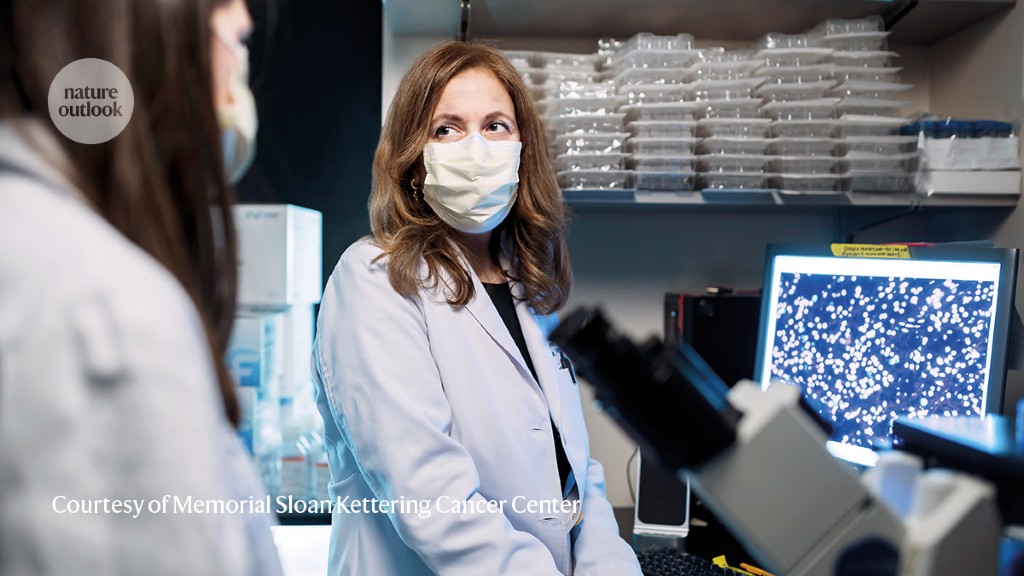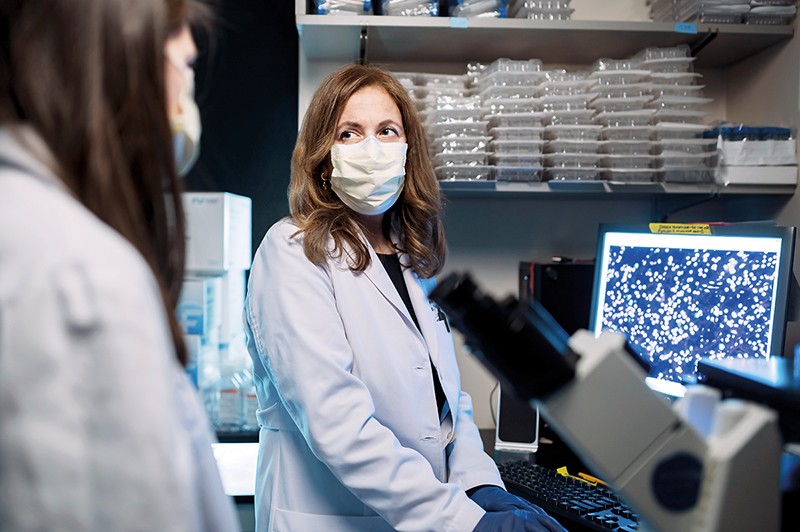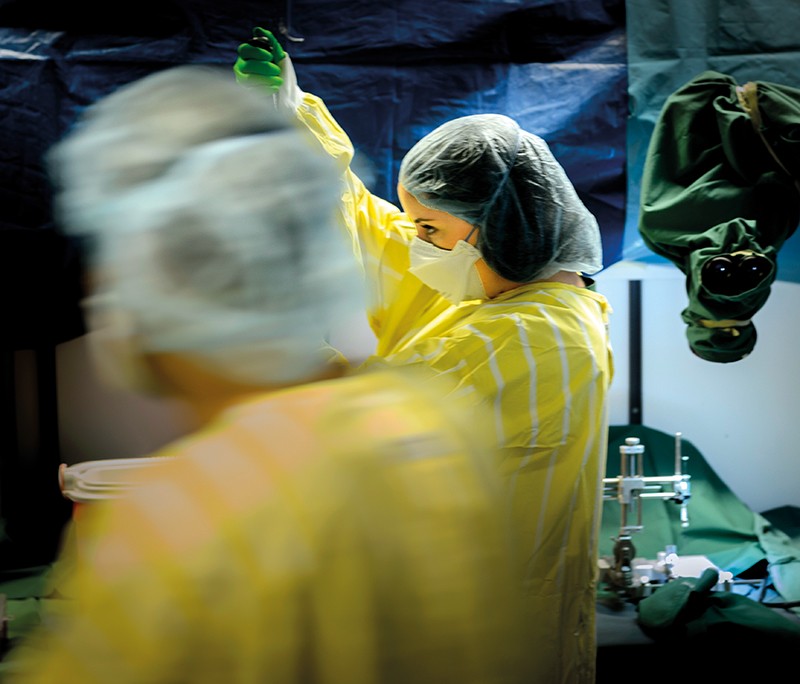Neurosurgeon Viviane Tabar has scrubbed in. In front of her is the first participant in a clinical trial to determine whether stem cells can be safely injected into the brains of people with Parkinson’s disease. The cells had been frozen, but they are now thawed and sitting on ice, waiting for their moment.
Tabar, a physician-scientist at Memorial Sloan Kettering Cancer Center in New York City, makes an incision in her patient’s scalp and drills a small hole in their skull. She then uses a brain scan “almost like a GPS”, she says, to guide her to the putamen — a part of the brain in which levels of the neurotransmitter dopamine are unusually low in people with Parkinson’s. Once she has confirmed that she’s reached the right spot, she injects the stem cells, then repeats the process on the other side of the brain. She hopes these cells will take hold and eventually begin to produce dopamine where otherwise there would be little or none. The surgery itself is minor enough that the patient can go home the next day.
Parkinson’s disease is a neurodegenerative condition that, among other things, affects movement, balance, gait and muscle control. Some of the most visible symptoms result from the loss of neurons in an area of the brainstem called the substantia nigra. The axons of these neurons extend up into the putamen, where they release dopamine that helps to regulate movement. Once around 50–80% of these neurons are lost, a person’s movement becomes noticeably affected.
This loss of substantia nigra neurons is what Tabar and others are working to solve. The first clinical trials investigating stem-cell therapy for Parkinson’s have already started — Tabar’s trial in the United States began earlier this year, and another kicked off in Japan in 2018. Others are scheduled to start in Europe in 2022. Stem-cell therapy is not a cure and, as critics point out, it could yield side effects that might be more difficult to control than the disease itself. But those pursuing this approach think that it could one day be the best bet for restorative therapy.
The first transplants
Because Parkinson’s stems from the dysfunction of one type of cell in a concentrated spot in the brain, the disease has long been viewed as an ideal candidate for stem-cell therapy. Restore dopamine, the thinking goes, and you can restore function. After all, the oral medication levodopa, which the brain converts to dopamine, has done just that since its approval in 1970. But taking it orally means a constant rise and fall in the brain’s dopamine levels. Over time, as the cells that convert levodopa to dopamine continue to die, symptoms become harder to control. People can experience uncontrollable movements — known as dyskinesias — during medication peaks, and a return of the tremor and slow movement typical of Parkinson’s during the troughs.
When treatment with levodopa reaches its limits, some people opt for deep-brain stimulation (DBS) — electrodes are implanted in specific areas of the brain and act as a pacemaker for neural impulses, blocking signals that cause abnormal movement. Both levodopa and DBS can be effective for different stages of the disease, but neither is perfect and they both lose potency as the disease progresses.
Although the specific type of neuron targeted by Parkinson’s disease extends from the substantia nigra, researchers are not yet trying to restore cells there. It could take a decade or more for those neural progenitor cells to grow axons long enough to reach the putamen. Instead, scientists began eyeing the putamen itself as a potential transplant site: it’s easier to access surgically and the new neurons don’t have to grow much to deliver dopamine to the right place.
The first transplants of neural progenitor cells into the putamen of people with Parkinson’s took place in the 1980s and 1990s1. At this time, stem cells were not yet a viable option, so the transplanted tissue came instead from donated fetal ventral midbrain tissue — an area of the developing brain containing neuronal cells fated to develop into everything from dopaminergic cells of the substantia nigra to ocular motor neurons. The scientists who performed these transplants hoped that, just as had been the case in rodent and non-human primate studies, the dopaminergic cells would become established and innervate the putamen.
“It was clear that if you did it right it would work, but it was really hard to do it right,” says Jeanne Loring, founding director of the Center for Regenerative Medicine at Scripps Research in La Jolla, California, who was working for a biotechnology company at the time that was involved in developing some of the initial studies.
The trials were instructive, if not wholly successful: some people saw little-to-no observable benefit, others developed disabling dyskinesias and some had such successful grafts that they were able to stop taking oral levodopa for a decade or more1. Loring and others say that the wide range of outcomes is probably due to a variety of factors, including the exact locations of the cell injections, lack of quality control of the fetal cells themselves, transplant rejection, poor cell survival and differences in genetics and disease states among individual patients.
Researchers studying the use of stem cells for Parkinson’s treatment think they have addressed most of those issues. Using either embryonic stem cell lines or induced pluripotent stem (iPS) cells — adult cells that have been reprogrammed back into a stem-cell-like state — they can create cell lines with known properties, and then conduct repeated tests to ensure purity and accurate staging. “With induced pluripotent cells, you can do as much quality control as you wish before you do the transplant,” says Loring. Assessments are much easier, she explains, when you have a cell line with known qualities that you can sequence and then test in animals before moving on to humans.
The trial Tabar is associated with is based on research from her laboratory and that of Lorenz Studer, a neuroscientist who runs the Center for Stem Cell Biology at Memorial Sloan Kettering. Their ten participants will receive dopamine progenitor cells derived from pluripotent stem cells, known as DA01, as part of a phase I trial conducted by BlueRock Therapeutics, a biopharmaceutical company in New York City that Tabar and Studer helped to found.
The next generation of trials
Studer was part of the initial studies1 involving fetal tissue in the 1980s and 1990s, and knew from the start that the work was more of a proof of principle than a solution for people with Parkinson’s. “For me it was clear that a fetal transplant isn’t a long-term solution because of ethical, legal and practical issues.” Because this procedure requires 4 to 12 fetuses per patient, there was no way they could treat thousands, let alone tens of thousands, of people that way. Instead, Studer turned to stem cells.
For almost two decades, Studer and others worked to find the best ways to create dopamine neurons, after finding that techniques that worked for mouse iPS cells didn’t work for human cells. “We needed to reinvent the techniques to coax a stem cell into [becoming] a dopamine neuron,” he says. In 2009, Studer and his colleagues reported that they had found two signalling inhibitors (known as Noggin and SB431542) that allowed the researchers to quickly convert up to 80% of embryonic stem cells into neural progenitors, and in 2011 they described how to further direct them to differentiate into dopamine neurons2. From there, they began to scale up the process to produce large, quality-controlled batches of dopamine-progenitor cells that could be cryopreserved2. BlueRock is the first to test this approach in Parkinson’s in a way that could provide for hundreds to thousands of patients at a time. Because the participants are receiving cells that were derived from a healthy donor, they’ll also require 12 months of immunosuppressive therapy to prevent transplant rejection.
Immunosuppression is a particularly important element of BlueRock’s approach, because it relies on a single cell line that cannot be adjusted to more closely resemble the recipient’s own tissues. A group led by stem-cell scientist and neurosurgeon Jun Takahashi at Kyoto University in Japan is attempting to provoke a lesser immune response by pairing transplant recipients with cells that are less likely to be rejected3. The researchers are using cell-surface proteins, called major histocompatibility complexes (MHCs), that are recognized by the adaptive immune system and can have varying levels of compatibility from one person to another. Rather than using frozen cell lines, Takahashi and his colleagues are creating a fresh batch of MHC-matched cells for each transplant.
Their trial began in 2018, and Takahashi says that the four patients with severe disease who participated are doing well (see also Nature https://doi.org/gfjxwt; 2018). He has yet to present efficacy results, but this isn’t surprising given that it can take from six months to two years before the transplanted cells fully take hold, innervate the putamen and produce enough dopamine to make a noticeable difference.
Both Takahashi’s group and BlueRock are limited in the data they are able to gather in their trials, however, simply because their participants already have fairly advanced disease. Ethically, it is often difficult to justify enrolling people experiencing earlier stages of the disease — they haven’t yet advanced to a point where a more extreme intervention that has not yet been shown to be safe is the best choice. However, once the disease has progressed, the brain might be less receptive to transplants. So although the trials can test for safety, efficacy signals will be much harder to pick up.
A European collaboration aims to start its own trials of stem-cell therapy for Parkinson’s disease in the next few months. The project, called STEM-PD, is led by Malin Parmar, a neuroscientist at Lund University in Sweden, together with researchers at Skåne University Hospital in Malmö, Sweden, and the University of Cambridge, UK. The group will use dopamine neuron progenitors derived from embryonic stem cells4, and is currently waiting on regulatory approval. Parmar and her colleagues plan to test their therapy in eight people, all with moderate rather than severe Parkinson’s. “We’ll start with mid-stage patients who still have a good chance of having benefits from the graft,” Parmar says.
Meanwhile, biotechnology company Aspen Neuroscience in San Diego, California, is focused on a different, personalized approach. The company, co-founded by Loring and based on technology from her lab, uses autologous iPS cells. These cells, originating from a patient’s own skin, have been induced back to the stem-cell stage and then prompted to differentiate into dopamine neuron progenitors. It’s a tactic that aims to avoid transplant rejection and the need for immunosuppressive drugs. But it’s also an involved, lengthy process and could be more expensive than other approaches — although according to Aspen’s chief medical officer, Edward Wirth, the company doesn’t expect to start human trials until the end of 2022 at the earliest, so they’re not speculating on costs just yet.
“At the end of the day, I don’t think anyone really knows what the best approach is, and there may not be just one approach because it may be different for different patients,” Parmar says. “But the trials going on today [are] the first-in-human proof-of-concept trials to show that stem-cell-derived dopamine neurons are safe and can have an effect in the patient’s brain.” From there, she notes, the technique can only be further improved. Whether that’s with an Aspen-inspired approach using patient-specific cells, or genetically altering the cells to prevent them from developing disease post-transplant, the basic idea is still the same: “Replace cells that are dead with new, functional cells.”
Devilish details
The basic idea might be promising, but mixed results from trials involving fetal tissue, combined with developing knowledge of how Parkinson’s progresses, have led some to express caution. Stem-cell transplants “will have some teething problems at the beginning, as any new therapy would,” says Tilo Kunath, a stem-cell biologist who studies Parkinson’s disease and neurodegeneration at the University of Edinburgh, UK. Parkinson’s is a complex condition, and Kunath thinks that some people could benefit more than others. Those with mutations in a gene called PARKIN, for instance, experience a form of Parkinson’s disease in which very little neurodegeneration is found beyond the substantia nigra. This group might therefore gain the most from stem-cell therapy, because they are usually not affected by symptoms that dopamine replacement cannot improve, such as poor balance, urinary problems and cognitive issues.
Others point out there is not yet a way to prevent the transplanted cells from eventually becoming diseased themselves. “If you get diagnosed with Parkinson’s disease and get stem cells, you may buy a period of time — 10 years — when you may not have to take a lot of medicine and you’re pretty stable,” says Jeff Bronstein, a neurologist and molecular toxicologist at the University of California, Los Angeles, who specializes in movement disorders. “This would clearly improve their quality of life, but it’s not a cure.”
Bronstein has seen hundreds of people with Parkinson’s over the years, including four who were part of the fetal transplant trials. One, he says, had a transplant that probably took hold, given that the individual was on a minimum dose of levodopa for more than 20 years afterwards. Yet he was still falling down frequently and had advanced dementia. “He was a successful patient, but the disease keeps progressing,” Bronstein says. “The mistake people make is that they look at [stem-cell transplantation] as disease-modifying therapy,” he says. “It’s not. It has the potential to improve disease symptoms, but it can’t alter the course of disease.”
Bronstein also points out that, unlike DBS or doses of oral levodopa, stem cells cannot be fine-tuned once they’ve been transplanted. “We’re sticking cells in there with no ability to control the amount of dopamine and when they’re releasing it,” he says. “We just hope they’ll do the right thing.” If they produce too much, as with the fetal transplants, patients could again experience runaway dyskinesias.
Although stem-cell therapy might fall short of curing Parkinson’s disease, its advocates are nonetheless enthusiastic about its promise. “I’m obviously biased, but I am very optimistic about the potential,” says Tabar. She says that using stem cells in combination with levodopa, DBS or potential new immunological therapies could help to slow or even stop the disease. “There’s going to be a very exciting road ahead.”








More News
Daily briefing: Carrion crows have counting skills seen only in people
Researcher parents are paying a high price for conference travel — here’s how to fix it
Asymmetric hydrogenation of ketimines with minimally different alkyl groups – Nature